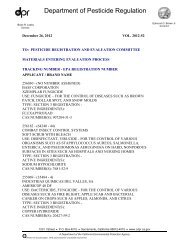Dichlorvos (DDVP) Risk Characterization Document - California ...
Dichlorvos (DDVP) Risk Characterization Document - California ...
Dichlorvos (DDVP) Risk Characterization Document - California ...
Create successful ePaper yourself
Turn your PDF publications into a flip-book with our unique Google optimized e-Paper software.
F. REPRODUCTIVE TOXICITY<br />
Summary: Exposure of rats to <strong>DDVP</strong> during reproduction resulted in the inhibition of plasma,<br />
erythrocyte, and brain ChE. Clinical signs were observed in both parents and offsprings. Other<br />
toxicity included decreased body weights and decreased water consumption. Re-mating of the F 1<br />
females after the F 2 generation showed decreased estrous cycling and increased incidence of<br />
abnormal estrus cycling. Mice exposed to <strong>DDVP</strong> containing resin strips showed only plasma ChE<br />
depression and no effect on reproduction. A summary of selected studies reviewed is listed in Table<br />
12.<br />
Dietary - Rat<br />
<strong>DDVP</strong> (93% purity; 0, 0.1, 1.0, 10, 100, or 500 ppm) in the diet was fed daily to CD rats (15/sex/group)<br />
for 3 generations (Witherup et al., 1965). The progenitor rats were dosed for 6 weeks before the first<br />
mating. No compound related effects in fertility, relative number of the progeny in each generation, or<br />
anatomical abnormalities were observed. The NOEL was greater than or equal to 500 ppm. The<br />
dosages were not estimated and body weight data were not included in the report. This study was<br />
unacceptable to DPR according to FIFRA guidelines (the diet was prepared once a week instead of<br />
daily, no individual data or histopathology data).<br />
Drinking water - Rat<br />
In a range-finding study for a two-generation reproductive toxicity study, Sprague-Dawley rats<br />
(10/sex/group) were given <strong>DDVP</strong> (purity not specified; 0, 20, 80, 200, or 400 ppm) in the drinking<br />
water (Tyl, 1990). The reported mean dosages were 0, 3, 12, 24, and 41 mg/kg-day from days 0 to<br />
14 for both sexes during premating period. During gestation (days 0-20), the reported mean dosages<br />
were 0, 3, 11.3, 22.1, and 47.9 mg/kg-day. During lactation (days 0-21), the mean dosages were 5.2,<br />
17.4, 44.4, and 77.3 mg/kg-day. Cholinergic signs were observed during all stages of reproduction in<br />
the parents and F 1 off-spring. At 400 ppm (48 mg/kg-day), tremors were first observed in the F 0<br />
females on day 7 of premating. At 200 ppm, tremors, rough coat, and lethargy were first observed in<br />
the F 1 off-spring on postnatal day 26. No observations were reported for the 400 ppm pups due to<br />
early sacrifices of moribund pups and high mortality. The plasma, erythrocyte, and brain ChE<br />
activities measured after pre-mating and mating exposure were reduced in a dose-related manner for<br />
all treated groups. At 20 ppm, the plasma, erythrocyte, and brain ChE activities for male-female were<br />
48-66%, 58-61%, and 54-93% of control values, respectively. Body weights, water intake, and food<br />
consumption when measured from premating to lactation were reduced, frequently statistically<br />
significant (p @ 0.05) for the dams in the 200 and 400 ppm groups and the NOEL was 80 ppm (11-17<br />
mg/kg-day for premating to lactation dosages). In addition to cholinergic signs, the food and water<br />
consumption, and average body weights were reduced in the 200 ppm pups. The fetal NOEL was 80<br />
ppm (11 mg/kg-day based on gestation dosages). The recommended doses for the definitive study<br />
were 0, 5, 20, and 80 ppm.<br />
In the definitive study, Sprague-Dawley rats (30/sex/group) were given <strong>DDVP</strong> (98.1% purity; 0, 5, 20,<br />
or 80 ppm) in the drinking water 24 hours daily (Tyl et al., 1992). The reported dosages for each<br />
group are listed in Table 11. Rats of both sexes were treated for 10 and 11 weeks during the<br />
premating period, respectively, for the F 0 and F 1 animals and were then allowed to mate for 3 weeks.<br />
Selected F 1 offspring were either necropsied or maintained to breed for the F 2 generation.<br />
Cholinesterase activities of the plasma, erythrocyte, and brain were determined after mating for the<br />
males, and after lactation for the females. Because of low reproductive performance, F 1 males were<br />
subjected to detailed reproductive assessment, and the F 1 females were studied for estrous cyclicity<br />
as well as mated with untreated males for the F 2 b generation. Decreased water consumption in both<br />
generations and reduced body weight in the F 1 parents were observed in the 80 ppm group.<br />
44
















